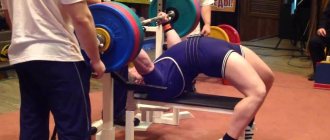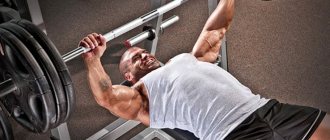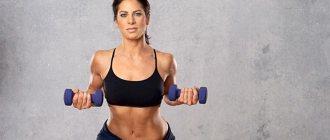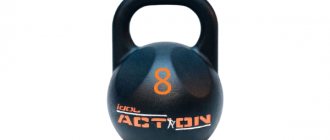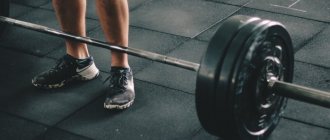Work, perseverance, willpower, endurance - a person who decides to take up a sport like weightlifting cannot do without this. Training in this sport is a whole system that must be followed if you want to achieve a truly impressive result. This topic is very interesting. It contains a lot of details, details and specific nuances. It’s impossible to tell about everything, but the most important things are worth noting.
Start date
Weightlifting training for beginners, of course, is radically different from the programs used by experienced professionals. But they were just getting started. There has been a lot of controversy about what the sequence of the methodological path should be. So far, no scientific research has been carried out on the issue, the results of which gave a substantiated answer to this question.
Classic exercises must be done in three groups: a jerk with two hands, lifting the barbell to the chest and pushing up from it. When mastering them, you need to remember the characteristics of the sport. The goal of weightlifting is to lift maximum weights. Therefore, the technique of competitive exercises must be studied in combination with a load (apparatus).
If a person does not comply with these fundamental requirements, then there will be consequences. In essence, he will master an erroneous, amateurish technique. If there is no significant additional weight, then the load during acceleration/braking of the bar will not reach the required value.
Already at this stage, a comprehensive approach can be seen, which requires the athlete to perform a number of additional exercises aimed at muscle development. For their successful growth, by the way, you need to follow proper nutrition, which implies a high protein content.
Mastering the Snatch
This is where weightlifting begins. Training aimed at familiarizing the athlete with the technique takes place with a barbell pole without weights. It all starts with pulling exercises and the starting stance. That is, a person lifts the barbell to the chest, while straightening the body and legs. Exercises are performed not only from the floor, but also from a certain height (the pole is taken from a box, stand, etc.).
You cannot do without these exercises, since only with their help a beginner can learn to straighten the body correctly. Only after mastering this technique can you begin lunge jerks. In no case with a squat! To get to this point, you must first master the basics and gain experience.
When learning to snatch, novice athletes perform general movement exercises without a apparatus. After that, they learn to clean the barbell. First without lunging. You can get to it only through mastering the squat. It is important to remember that traction plays an important role here, so you should not neglect performing exercises from different positions. By the way, the chest push is also performed without lunges at first.
To connect it with the push, you need to place the barbell on the racks, aligning them at chest level. This is the starting position. From there the athlete performs a push and a lunge. Once these movements are mastered at a decent level, you can combine them.
The importance of sports in human life
Unfortunately, human health is a fragile and fickle concept. Our body is susceptible to numerous diseases and problems. But there are several rules that will help any person maintain strength and vigor for as long as possible. To stay healthy we need a healthy heart, proper metabolism and good circulation. Since childhood, we have been running outside, playing outdoor games, and breathing fresh air. At the same time, our muscles develop and gain strength, grow, and the heart pumps oxygen-enriched blood. After playing, children want to eat, and healthy food contributes to the growth and development of the body. Everything is functioning correctly.
But as we get older, we often begin to lead less active lifestyles, especially in middle age. Sedentary work, lack of oxygen and movement make us weak. The body freezes, the blood does not deliver useful microelements to all organs, in particular to the brain. The result is weakness, bad mood and illness. Therefore, it is extremely important to exercise. Any type suitable for you.
Working on biceps
Weightlifting cannot do without it. Workouts, as beginners believe, should include bending (exercises with dumbbells, for example) to make the arms larger. But in fact this statement is somewhat erroneous. It is necessary to do the notorious exercises, as well as everything that can help with them: deadlifts and overhead presses, squats on the front and back, pushes. The bottom line is that this is what affects the size of your arms. Power snatches, pull-ups with a snatch and push grip, squat cleans - this can significantly strengthen your arms. To be more precise, the brachialis and brachioradialis muscles.
Many trainers do not recommend doing bending at all, because they waste energy, and it can be spent on more useful exercises that contribute to the development of larger muscle groups that affect the efficiency of lifting weights. Moreover, the vast majority of flexions have a negative impact on arm flexibility. And it is necessary to lift the barbell.
Professional athletes, when describing weightlifting training for beginners, place special emphasis on the fact that large arms, which beginners often chase after, often lead to problems with holding the barbell in the front position. And no matter how much strength an athlete has, it will be difficult to lift and push due to the lack of flexibility. Therefore, if you want not only to be a weightlifter, but also to have huge arms, you need to forget about bending and pay more attention to deadlifts.
Triceps
But there is no way to do weightlifting without working out this part of the arms. Training must include exercises for their development. Large triceps are not only a hindrance - they will help when lifting the barbell.
To develop them you need to do bench presses. These exercises develop both the shoulders and arms, and the back and legs. In other words, they help improve the supporting force needed to secure the barbell overhead and then hold it. It is the active execution of bench presses with the maximum possible weight that contributes to the appearance of the huge horseshoe-shaped triceps observed in the best athletes.
These exercises must be approached responsibly. All the weight must be squeezed out, and this is not as easy as it may seem. And when it starts to work out really well, you need to add another 10 kilograms. And then another 10. And so systematically. It’s difficult, but just look at the results of professionals who, using a similar technique, have learned to squeeze a weight that is one and a half times their own! And this is not the limit. Russ Knipp, for example, bench pressed twice his own weight.
Weighted push-ups also influence the development of triceps (as well as the back, arms and legs, respectively). It is worth combining them with a bench press, since such push-ups work the triceps differently. We must remember that this muscle is much more complex than the biceps, so it is worth performing different exercises to engage all its parts and achieve the best result.
Assistive technology
Since it is highly recommended to include weighted push-ups in your weightlifting training plan, it is necessary to talk about how to do them.
First you need preparation. A beginner needs to learn how to do three sets of twenty full push-ups. When successful, you can add weight. Some weightlifters use a belt specially designed for this purpose. Others hold dumbbells between their legs. Still others place a barbell “pancake” on their back. All options are good, but if a person intends to engage in this sport professionally, then he will need a belt in any case.
So what is the purpose of push-ups? 50 kilograms + athlete weight. Having achieved this goal, you will need to increase it. Add weight little by little. It is recommended to do push-ups every week and change the number of approaches and repetitions each time. Four by eight, five by three, two by five, three by three. And once a month - a record push-up. But all approaches should always be completed by performing the exercise with a reduced weight. Minus 25 kilograms - and as many times as possible.
Another exercise that should be included in your weightlifting training plan is the straight arm pullover. Why is it needed? Because this exercise works the long part of the triceps to the maximum. It is done either with dumbbells or with a barbell. To perform a pullover, you need to lie on a bench (your head should hang over the edge) and accept the barbell from someone who will help. Having determined the amplitude that is convenient for you, you need to extend your arms to the starting position. Then do a pullover (one set - 20 repetitions) and rest. We must remember - your arms should be as straight as possible. Bending is allowed at the moment when the dumbbell/barbell falls below the head. In preparation for the second approach, it is worth taking more weight. Many beginners are surprised to note that the next 20 repetitions with heavier dumbbells are easier than the first.
The benefits of weightlifting exercises
Sets of exercises with a barbell are an effective way to hone technical skills, develop strength, physical stamina and endurance. They will teach you to work and stay in shape both in a state of fatigue and with a rapid heart rate - two of the most important benchmarks of functional fitness.
It's one thing to push or snatch when you're fresh and full of energy, but it's completely different when you're doing it after 800m of running or in your tenth round of training.
Before moving on to the complexes and tips that will help you improve your skills and get more benefits from your training, let us remind you about special shoes for weightlifting - the so-called weightlifting shoes. They provide support and stability so you can create explosive power and keep your feet stable during any workout.
Methodology A.S. Medvedev
I would like to pay special attention to the long-term training system in weightlifting developed by Alexei Sidorovich Medvedev, a Soviet weightlifter, champion and record holder of the USSR, Europe and the world. This man published more than 400 works (17 of which abroad), which he devoted to the development of this sport in the country and in the world, as well as to the organization and planning of the educational and training process.
His weightlifting training system is recommended for every person who wants to train professionally. The best publication is considered to be the work published in Moscow in 1971, known as “Multi-year training planning.”
Medvedev emphasized that weightlifting is a speed-strength discipline in which two facets of activity are inextricably linked. Practicing this sport involves improving both physical qualities (including special ones) and technical skills. Every athlete must understand that weightlifting is impossible without creating the best biomechanical conditions for action that can realize his potential.
Awards
Immediately after the competition, the awards ceremony takes place:
Typically, this ceremony is performed by famous athletes of past years. In the center of the photo is Boris Selitsky, the 1968 Olympic champion, who set 2 world records:
Training philosophy
The Soviet approach had a special vision for weightlifting. Physical activity was perceived as a stimulus to which the body reacts by changing its functions. That is, as a result of training, there is an intensification of metabolism, improved blood circulation and energy exchange, active breathing and much more. Yes, upon completion, the athlete’s condition will stabilize. But the effects of the workout, like the increased metabolism, continue.
Awareness of this physiological feature was the basis of the Soviet approach. Training is not just physical activity and a way to fill muscles with micro-tears. This is what affects the restructuring of the body and affects the biological system as a whole. Seeing the load from this perspective gives a holistic view of the impact of the stressor (training) and helps to maximize the potential of a weightlifter when creating an individual program for him.
Bulgarian training system
In weightlifting, the name of such a coach as Ivan Abadzhiev is widely known. He trained the champions of Qatar and Turkey, so many are guided by his programs.
The good thing about the Bulgarian method is that there is no danger of overtraining. The principle is this: by moving consistently and gradually, you manage to adapt your body to stress, which is initially physical activity for it. Ideally, you should spend half of your active day training and not take days off. That's what weightlifting is. Training once a week is not a way to achieve visible results in this sport.
In addition, the likelihood of injury and chronic fatigue is much less if you do not take days off, since adrenaline constantly circulates through the body, promoting protein synthesis. Also, professional athletes who train using this method adapt to the most impressive weights in advance, while their opponents try them only directly in competitions.
However, the essence of the methodology can be described by Abadzhiev’s main motto, which all his students learn. And it goes like this: “Never try to do less than the maximum.”
Russian TA Cup
My friend, Ilya Popov, took part in the most serious competition in the country - the Russian Cup. The Cup was in Orel and took place last week.
I decided to provide moral support and go to Orel for company.
Met a minion:
After which we loaded into the car, drove 1200 kilometers and checked into a hotel:
Useful tips
Weightlifting training involves performing a variety of exercises, many of which seem simple, but are actually very specific and complex. Therefore, it is important to take recommendations into account during the process.
A weightlifting training program includes exercises that begin with hanging barbells. To get them, you need to fix it in its original position for three to four seconds.
It is recommended to do exercises to develop the abdominal muscles and back muscles before each workout. Both with and without weights. The norm is 4 sets of 8 repetitions, then you can increase it if desired. Then you need to perform a series of jumps.
When performing the same type of exercises, there is no need to do intermediate approaches. It is also recommended to try different weights before starting. And, by the way, adjust the load according to how you feel.
When doing snatch deadlifts, you need to take 3-4 seconds to stop, fixing the barbell. The exercise is performed confidently, but without fuss. The barbell lowers calmly.
Also, universal weightlifting training programs include bending over with weights. You need to choose a weight that can realistically be lifted 8 times in 4 approaches.
Weightlifting Safety
Any sport is dangerous if safety precautions are not followed. By training with an experienced instructor, following his requirements and rules, you minimize possible harm. To prevent joint problems, take vitamins regularly and eat right. Stretching exercises after each strength load are beneficial for muscles and tendons. This will also protect your joints. It is not recommended to get carried away with the consumption of proteins and accompanying sports chemicals. Again, an experienced trainer will tell you the correct way to use sports nutrition that will not harm the liver and stomach. A daily massage after weightlifting exercises will protect you from unnecessary pain. It will also promote rapid muscle recovery.



